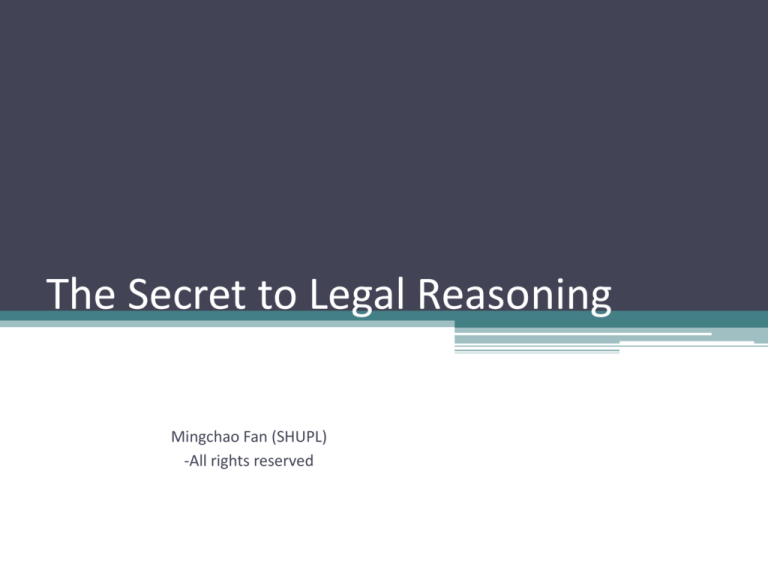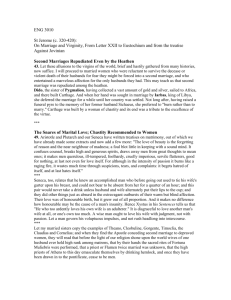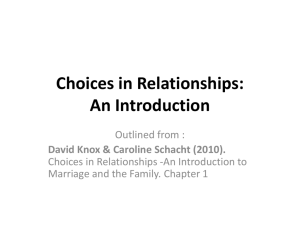
The Secret to Legal Reasoning
Mingchao Fan (SHUPL)
-All rights reserved
What is IRAC?
• I—usse: to identify the issue
• R—ules: to state and explain the rules
• A—pplication: to apply the rules to the facts
• C—onclusion: to conclude
An Example For IRAC
• Facts:
• Paul Quint and Melody Jones, residents of British Columbia,
after ten years of marriage, are getting divorced. They have
two children, Lindsay and Wayne, and have agreed that the
children will stay with Melody. However, they cannot reach an
agreement as to the division of property. They own a house
and a boat on Salty Island. In addition, two years ago, Melody
was given an $20,000 gift from her grandmother, which she
put into a separate bank account in her own name.
An Example For IRAC
• Issue:
• How the assets, namely, the house, the boat and $20,000 in
the bank account under Melody’s name, should be divided
when Paul and Melody divorce.
An Example For IRAC
• Rules(statement):
• Family Property Act (applies to all residents of British Columbia)
• S.8
Upon marriage breakdown each spouse is entitled to a half
interest in the family assets.
• S.9 (1)
Property owned by one or both spouses and ordinarily used
by a spouse or a minor child of either spouse for a family purpose is a
family asset includes:
• (a) money, including inheritances or gift, obtained while in the marriage;
• (b) a right of a spouse under an annuity or a pension, home ownership or
retirement savings plan;
• (c) a right, share or an interest of a spouse in a venture to which money or
money’s worth was, directly or indirectly, contributed by or on behalf of
the other spouse.
An Example For IRAC
• Rules (statement):
• Family Property Act (applies to all residents of British Columbia)
• S.10 Where the provisions for division of property between spouses under
S.8 would be unfair having regard to:
• (a) the duration of the marriage;
• (b) the duration of the period during which the spouses have lived separate
and apart;
• (c) the date when property was acquired or disposed of;
• (d) the extent to which the property was acquired by one spouse through
inheritance or gift;
• (e) the needs of each spouse to become or remain economically
independent and self sufficient, or;
• (f) any other circumstances relating to the acquisition, preservation,
maintenance, improvement or use of property or the capacity or liabilities
of a spouse.
An Example For IRAC
• Rules (statement): Bogman v. Bregman
• Jill Bogman petitioned for a divorce from her husband, Keven
Bregman, and asked the court to make a determination about
the division of assets. The court declared that pursuant to S.8
of the Family Property Act a summer cabin, a camper van, and
the contents of matrimonial home were family assets and
were divided equally between Jill and Kevin. A question arose
as to whether Jill’s registered retirement plan was a family
asset. Jill acquired the plan through a monetary gift from her
mother and kept it in a separate bank account under her
name.
An Example For IRAC
• Rules (statement): Bogman v. Bregman
• The court held that the retirement savings plan was not to be divided
equally between Jill and Kevin. Although the savings plan was
automatically included within the definition of family assets under
S.9(2)(b) of the Family Property Act, the fund was a gift from her mother,
not used for family purpose, and was kept in a separate bank account.
Therefore the court exercised its jurisdiction under S.10 of the Family
Property Act. Although the court considered the fact that the gift had
been received ten years prior and was fairly entrenched in the family
assets, this factor was not deemed to be as relevant as the other facts in
this particular situation.
An Example For IRAC
• Rules (explanation):
• 1. The law provides that upon marriage breakdown “family
assets” must be shared equally between the marriage
partners. Family assets include gifts, inheritances, and
registered retirement savings plans obtained while in the
marriage.
• 2. However, a court may alter this division if the division
would be unfair having regard to a number of factors
including “the extent to which property was acquired by one
spouse through inheritance or gift” pursuant to S.10(d) of the
Family Property Act.
An Example For IRAC
• Rules (explanation):
• 3. A case that interpreted this section (Bogman v. Bregman)
found that in determining whether the inclusion of a gift is
unfair and the extent to which the property was acquired by
gift the court would look at the following three factors:
• -- Whether the gift was kept in a separate bank account
• -- Whether it was used for family purposes; and
• -- How long it had been in the hands of the recipient.
An Example For IRAC
• Application:
• 1. the division of the house and the boat
• --The house and the boat are owned by the both spouses and
ordinarily used for family purpose;
• --They fall in the definition of “family assets” under S.9(a);
• --Being family assets, they shall be equally divided according
to S.8.
An Example For IRAC
• Application:
•
•
•
•
•
•
2. the division of $20,000
--$ 20,000 is not a family asset and should not be equally divided because
--It was a gift received while Melody and Paul were married;
--However, it was a gift from Melody’s grandmother;
--it was kept in a separate account;
--accordingly, it was not used for family purposes and cannot be deemed
as a family asset as defined in S.9;
• --therefore, it should not be shared equally between the marriage
partners pursuant to S.8.
An Example For IRAC
• Application:
•
•
•
•
2. the division of $20,000
Alternatively
--Even if $20,000 is a family asset, it should not be equally divided because
--Melody received $20,000 only two years ago. It is doubtful if it has been
entrenched in the family assets;
• -- Even if it has, it is not as relevant as the fact that it was a gift from
Melody’s grandmother, kept in Melody’s separate bank account and not
used for family purposes, according to Bogman v. Bregman;
• --It would be unfair to divide $20,000 equally between Melody and Paul,
pursuant to S.10(d);
• --Therefore, $20,000 should not be equally divided.
An Example For IRAC
• Conclusion:
• $20,000 should not be divided equally between Melody and
Paul.
An Example For IRAC
• Facts:
• Person A walks into a grocery store and picks up a loaf of bread. He then
stuffs the bread beneath his jacket. A security attendant sees him and
follows him to the cash register. Person A passes through without stopping
to pay for anything. The security attendant stops him at the gate. He
detains person A while he interrogates him. Person A is unresponsive and
uncooperative and in fact downright hostile to the charges being leveled
at him by the security attendant. Person A is held for a period of two
hours at the end of which it is found that he had actually put the loaf of
bread back and was not stealing. Person A sues the grocery store for false
imprisonment. Would person A prevail in court?
An Example For IRAC (continued)
• Issue:
• Does the detention of Person A constitute a falsely imprisonment?
An Example For IRAC (continued)
• Rules:
• Most jurisdictions in the United States allow recovery for false imprisonment. The
courts look at two elements in determining whether a person has been falsely
imprisoned, namely just cause and authority. In looking at the element of just
cause, courts further analyze two factors: reasonable suspicion and the
environment in which the actions take place.
• If a person suspects that he is being deprived of property legally attached to him
and he can show that his suspicions are reasonable then he is said to have a
reasonable suspicion. Courts also look at whether the activity in question took
place in an environment where stealing is common. Crowded public places and
shops are considered to be more justifiable places where a person could have just
cause for reasonable suspicion in comparison to private property or sparsely
populated areas.
An Example For IRAC (continued)
• Rules:
• In looking at the other element of authority, the courts tend to favor people
directly charged with handling security as people with the authority to detain a
person in comparison to private individuals. The courts have made exceptions in
the favor of the person conducting the detention if he is a shopkeeper. This special
privilege is called the shopkeeper's privilege. In general the element of authority is
usually seen as one part of a two part legal justification for legally justifiable
detention. For example in cases involving detention by an officer of the law, courts
have ruled that the officer has to have both just cause and authority. Authority in
itself is not enough. The same reasoning applies to all detaining individuals.
Exceptions are made in the case where a person of authority has to conduct an
investigation with just cause and courts usually grant a reasonable amount of time
in detention for this purpose. Here the reasonable amount of time a person can
be kept in detention is directly related to the circumstances under which the
detention takes place.
An Example For IRAC (continued)
• Application:
• Person A was conducting his activity in a crowded place that
happened to be a grocery store. He was further detained by a
security attendant. The security attendant had seen him pick
up a loaf of bread and walk past the cash register without
paying. The security attendant detained him until he
discovered that no theft had taken place. Person A was
subsequently released upon this determination of fact.
An Example For IRAC (continued)
• Application:
• A court looking at these facts would try to apply the two elements of false
imprisonment. The first element of false imprisonment is just cause. The first
factor of just cause is reasonable suspicion. The security attendant saw person A
pick up a loaf of bread and stuff it beneath his jacket. This is an uncommon action
as most grocery shop customers usually do not hide produce under their personal
belongings. The security attendant, therefore, has reasonable suspicion because a
reasonable person in his place would have also considered this action to be
suspicious. Person A further walks by the cash register without paying. The
security attendant has already seen person A hiding the bread under his jacket
and honestly believes that person A is still in possession of the loaf of bread. A
reasonable person in the security attendant's stead would arguably act to stop
person A. Thus, this seems to satisfy the first factor of the element of just cause,
reasonable suspicion.
An Example For IRAC (continued)
• Application:
• The second factor of the element of just cause is the
environment. The activity takes place in a grocery store. A
grocery store is usually a place where shoplifters and other
thieves operate regularly. This reduces the burden of just
cause placed on the person performing the detention. The
security attendant has to be unusually vigilant and suspicious
of a person's motive because of his location. This then seems
to satisfy the second factor of the element of just cause,
environment.
An Example For IRAC (continued)
• Application:
• The second element of false imprisonment is authority. The person performing the
detention of A is the security attendant of the grocery store. He is the person
charged with securing the grocery store and its property. The security attendant
sees person A put the loaf of bread underneath his coat and walk through the
checkout without paying. The security attendant now has to act because he has
been charged with the security of the store and he has just cause. The security
attendant performs the investigation after he puts person A in detention and it
takes two hours. Two hours might seem like an unreasonable amount of time but
given the fact that person A was unresponsive and uncooperative it seems to be
reasonable. It also seems as if the security attendant was doing his due diligence
as he releases person A as soon as the facts are established and it is shown that
person A was not stealing the loaf of bread.
An Example For IRAC (continued)
• Application:
• Finally we have to look at the fact that since the activity took
place in a grocery store, the shopkeeper's privilege applies
directly to the security attendant in charge of securing the
store and its property. This privilege gives the security
attendant extra leeway in detaining people in whom he has
reasonable suspicion. Most courts would lean heavily towards
the shopkeeper because person A was on the property of the
grocery store and thus could be subjected to extra scrutiny
given the long history of the shopkeeper's privilege in
common law.
An Example For IRAC (continued)
• Conclusion:
• The detention of Person A most unlikely constitutes false
imprisonment because the security attendant does not satisfy
either element of false imprisonment. The detention of
person A was legal because the security attendant had both
just cause and authority. Additionally, the shopkeeper's
privilege further solidifies the legality of the detention. Person
A, therefore, has no recourse under the law.
An Example For IRAC (continued)
• Discussion:
• What if this happens in China?
• Identify the issue as
• Does the detention of Person A constitute a criminal
offense, namely, falsely imprisonment?
An Example For IRAC (continued)
• Discussion:
• What if this happens in China?
• Rules:
• 第二百三十八条 非法拘禁他人或者以其他方法非法剥夺他人人身自
由的,处三年以下有期徒刑、拘役、管制或者剥夺政治权利。具有殴
打、侮辱情节的,从重处罚。
• 犯前款罪,致人重伤的,处三年以上十年以下有期徒刑;致人死亡的,
处十年以上有期徒刑。使用暴力致人伤残、死亡的,依照本法第二百
三十四条、第二百三十二条的规定定罪处罚。为索取债务非法扣押、
拘禁他人的,依照前两款的规定处罚。国家机关工作人员利用职权犯
前三款罪的,依照前三款的规定从重处罚。
Exercise
• 案件事实:
• 成年人甲以个人积蓄1,000元在慈善拍卖会拍得
明星乙表演用过的道具,市价约100元。事后,
甲觉得道具价值与其价格很不相称,颇为后悔,
希望撤销该合同。
Exercise
• 适用法条:
• 《合同法》第五十四条
• 下列合同,当事人一方有权请求人民法院或者仲裁机构变
更或者撤销:
(一)因重大误解订立的;
(二)在订立合同时显失公平的。
一方以欺诈、胁迫的手段或者乘人之危,使对方在违背真
实意思的情况下订立的合同,受损害方有权请求人民法院
或者仲裁机构变更或者撤销。
当事人请求变更的,人民法院或者仲裁机构不得撤销。
Exercise
• Fact Pattern:
• Kendra Pendleton and Tom Shipton, both Montana residents, met in January 2009 and
dated regularly during the first six months of that year. On the weekend of June 18,
2009, the couple rented a cabin, and on Sunday June 20, 2009, Tom woke up a little
earlier than Kendra and gently nudged her awake. When she woke up he asked her to
get out of bed and stand up. Then he got down on one knee and said, “I don’t believe a
justice of the peace or minister is necessary to make a bond of marriage between two
people. I want us to be together forever. Will you be my wife?” Kendra said yes and
from June 20, 2009 forward, the parties held themselves out in public as husband and
wife.
• On November 8, 2009, Kendra ended the relationship and asked Tom to leave the
marital home, which Kendra had purchased before the marriage. As Tom was leaving,
Kendra handed Tom a piece of paper and said, “In case you thought I did not know.”
The paper was a photocopy of an order dated October 8, 2009 granting Tom a divorce
from Ms. Tammy Brethren.
• Is the parties’ June 20, 2009 agreement to marry valid?
Exercise
• Authorities to be used:
• 1. Montana Code Annotated 2003
• 40-1-101. Purposes.
• This chapter shall be liberally construed and applied to promote its
underlying purposes, which are to:
(1) provide adequate procedures for the solemnization and registration
of marriage;
(2) strengthen and preserve the integrity of marriage and safeguard
family relationships.
• §40-1-403, Formalities.
• Common-law marriages are not invalidated by this chapter…
Exercise
• Authorities to be used:
• 2. Estate of Vandenhook, 259 Mont. 201 (1993).
• The girlfriend filed a demand for notice and a statement of her interest in the
estate as the decedent's common law wife and a beneficiary under the will. The
estate filed a motion for a summary judgment. On consideration, the district court
ruled that the girlfriend did not establish a claim and entered a summary
judgment for the estate. On appeal, the girlfriend contended that she and the
decedent entered a common law marriage. The court affirmed the judgment
denying the girlfriend's claim and held that the girlfriend had not met her burden
of demonstrating a genuine issue of fact as to the third element necessary to show
a common law marriage, cohabitation and repute. To establish a common law
marriage the party alleging the existence of the marriage had the burden of
proving: 1) that the parties were capable of consenting to the marriage; 2) that
the parties assumed such a relationship by mutual assent and agreement; and 3)
that the parties established the marriage by cohabitation and repute.
Exercise
• Authorities to be used:
• 3. Estate of Schanbacher, 182 Mont. 176 (1979)
• Prior to his death, the deceased, who travelled often for business and used two
surnames, had two separate wives and families. His first wife predeceased him, and
he continued his relationship with his second, common law wife. After his death, a
child of his first marriage was appointed the personal representative of the deceased's
estate. The common law wife and children filed a petition for family allowance,
exempt property, a homestead allowance, and a widow's elective share of the
deceased's estate. Summary judgment was entered against the common law wife and
children, and their petition was dismissed. On appeal, the court reversed the
summary judgment and remanded for a trial on the merits. Montana recognized
common law marriages under Mont. Code Ann. §40-1-403. The court held that after
the death of the first wife, the relationship between the deceased and the second wife
constituted a common law marriage. The court remanded for a determination of
whether the children of the common law marriage were considered issue of the
decedent; a fact issue that could not have been determined by summary judgment.
Exercise
• Authorities to be used:
• 4. Estate of Alcorn, 263 Mont 353 (1994)
• The heir argued that the decedent's wife failed to prove that she and the decedent
were ever married. The court affirmed the judgment of the trial court. The court held
that there was sufficient evidence to support a finding that a common law marriage
existed between the decedent and the decedent's wife under Mont. Code Ann. §40-1403. The court found that the cohabitation of the decedent and the decedent's wife
prior to her final divorce was not fatal because they became competent to enter into
marriage as of the date of the removal of the impediment pursuant to Mont. Code
Ann. §40-2-401(2). The court also found that the parties evidenced their mutual
consent by buying a wedding ring and by designing their marital home. The court
further found that the cohabitation and repute requirement was met because they
cohabited for nearly nine years and held themselves out as husband and wife by the
decedent's wife wearing the wedding ring, sharing a joint checking account, hosting
family gatherings and other parties at their home, and by witness testimony that the
decedent and the decedent's wife were considered to be married.
Exercise
• Authorities to be used:
• 5. Matthews v. Britton, 303 F.2d 408, 409 (1962)
• The record disclosed that in 1935, the claimant and alleged husband had mutually
agreed to live together as wife and husband and began their cohabitation, which
continued uninterrupted until the alleged husband's death in 1957. However, in 1919,
the claimant had been legally married to another man and had remained married to
him until he secured a divorce in 1951. On this basis, the claimant's application for
benefits as a surviving common-law wife under the Longshoremen's and Harbor
Workers' Compensation Act was denied. On appeal, the court agreed that, in the
absence of a valid divorce, the claimant's marriage to another man precluded any
other lawful marriage by her, no matter how much she and the alleged husband had
purported to be lawfully married or how much they acted as if they were married.
However, the record as a whole supported a finding that there was an agreement to
be married before the impediment was removed and continued thereafter to cohabit
and live together as husband and wife. Thus, a common-law union was effected when
the divorce was awarded in 1951.
Sample Answer
• ¶1 Did Kendra Pendleton and Thomas Shipton have the ability to
consent to common law marriage if Tom was married when he asked
Kendra to be his wife on June 20, 2009?
• ¶2 Common law marriage is recognized in Montana under § 40-1-403,
Mont. Code Ann. (2003), and exists if two people: (1) have the capacity to
consent, (2) consent, (3) cohabitate and engage in public repute. Estate of
Vandenhook, 259 Mont. 201 (1993). The first element, capacity to
consent, cannot exist if there is a previously existing marriage. See § 40-1401(1)(a), and (2), Mont. Code Ann. (2003). Upon the first marriage’s
termination, the second marriage can immediately come into existence if
the other elements of common law marriage exist. See Estate of
Schanbacher, 182 Mont. 176 (1979); Estate of Alcorn, 263 Mont 353
(1994).
Sample Answer
• ¶3
In Estate of Schanbacher, the court held that the decedent had the capacity to
consent to his second marriage after his first wife’s death. 182 Mont. 176, 181 (1979).
Decedent married his first wife in 1916 and remained married to her until her death in 1973.
Id. at 177. Decedent married appellant, his second wife, by wedding ceremony in 1952 and
lived with her until his death in 1976. Id. at 177, 180. In upholding the second marriage
upon the first wife’s death the court commented that § 40-1-401, Mont. Code Ann. (2003), is
based on a progressive policy and stated that once parties agree to marry they do not need
to agree again once the marriage impediment is eliminated. Id. at 183; citing Matthews v.
Britton, 303 F.2d 408, 409 (1962).
•
• ¶4
In Estate of Alcorn, the court held that the parties had the capacity to consent to a
common law marriage upon the termination of the respondent’s first marriage. 263 Mont
353 (1994). Respondent and decedent lived together from August 1981 until decedent’s
death in 1991, and respondent’s divorce in a prior marriage was finalized in May 1985. Id. at
354. The court’s decision in Alcorn was based in part on the plain language of § 40-1-401(2),
Mont. Code Ann. (2003), which states that parties cohabitating after removal of an
impediment are lawfully married as of the date the impediment is removed. Id.
Sample Answer
• ¶5 Tom and Kendra had the capacity to consent to marriage in the
present case after Tom’s divorce in a prior marriage was finalized. The
parties consented to marriage on June 20, 2009, and held themselves out
as married until November 2009, despite Tom being married to Tammy
Brethren until October 8, 2009. The present case is similar to
Schanbacher and Alcorn because in both precedent cases, courts held that
the parties had the capacity to consent to a second marriage when their
previous marriages ended. Additionally, under Schanbacher, Tom and
Kendra do not need to restate their consent to marry once they have
capacity, even if their consent occurred before the capacity to consent
existed. 182 Mont. at 183; citing Matthews v. Britton, 303 F.2d 408, 409.
Once Tom’s divorce from Tammy Brethren was finalized on October 8,
2009, the parties had the capacity to consent and their consent to marry
from June 20, 2009 became valid.








